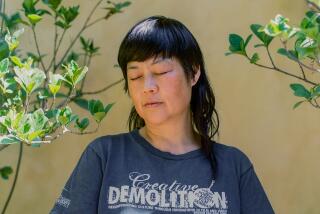Madame Chiang’s Private Side Is Revealed in Her Paintings
- Share via
NEW YORK — An old Chinese tale about three sisters says: One loved money, one loved power and one loved China. It’s a story about the famous Soong sisters, who helped shape modern China. The sister who loved power became Madame Chiang Kai-shek, wife of the powerful general and later deposed ruler of China.
That is what the public knows of Madame Chiang, who, on behalf of her husband, traveled to the United States and other parts of the world to speak out against Communism.
But there is another side few know anything about: She is an artist.
That side surfaced recently when 10 of Madame Chiang’s paintings--depicting flowers, bamboo leaves and other scenery, done in ink on rice paper--were put on display for the first time in the United States at the office of the World Journal, a Chinese-language newspaper in New York City.
The exhibition, which also includes calligraphy and paintings by five other Chinese artists, is on view until Sunday, when it travels to San Francisco.
Madame Chiang, now 102, was a friend and confidant of world leaders and U.S. presidents, from Lyndon B. Johnson to Franklin D. Roosevelt, who considered her “hard as steel.” She has been living in virtual obscurity since coming to the United States in 1975, the year her husband died. (Gen. Chiang and Madame Chiang fled to Taiwan after the Communists in China ousted the repressive Chiang government from power in 1949.)
For two decades, Madame Chiang lived in a 36-acre hilltop estate on Long Island until the estate was sold to a developer and its elaborate furnishings auctioned off.
These days, she gets around in a wheelchair on those occasions when she leaves her Manhattan apartment. She made a rare public appearance on New Year’s Day when she visited the newspaper office where her work is being shown.
Madame Chiang has not given interviews in decades, but her niece, Ling-E Kung, said that Madame Chiang liked the idea of taking part in this exhibition.
“She was quite pleased that people were interested in her artwork,” Kung said in a recent interview.
The exhibition was organized by the Chinese-language newspaper to celebrate the third millennium and the paper’s 25th anniversary.
On the day the exhibit opened, it drew about 2,000 visitors, many of them Chinese. They came mainly to see Madame Chiang’s paintings, most of which were done in Taiwan in the 1950s and 1960s. Chris L. Tang, 41, a teacher from Brooklyn who saw the exhibit with his wife and parents, said he came because Madame Chiang is an important figure in modern Chinese history.
Tang found her work “very good,” an opinion he did not expect to come away with.
In her paintings, people and nature are one, said Tang. Absent from the paintings, he noted, was the desire for power or politics. Instead, Tang said, he found they showed a person who is at peace with herself.
“When she painted these, she probably forgot about the world,” said Tang, who himself dabbles in calligraphy.
Madame Chiang’s only other public exhibit was years ago, in Taipei, Taiwan, when the National Palace Museum included one of her pieces in a show.
The 10 pieces on view represent her favorites and were selected by Madame Chiang herself, Kung said. The one she considers particularly special shows a bolt of lightning breaking across the sky. The composition departs from tradition, because, typically, Chinese paintings do not include lightning, Kung said.
“The lightning, water and sky--it’s a rare combination,” Kung said.
More to Read
The biggest entertainment stories
Get our big stories about Hollywood, film, television, music, arts, culture and more right in your inbox as soon as they publish.
You may occasionally receive promotional content from the Los Angeles Times.










